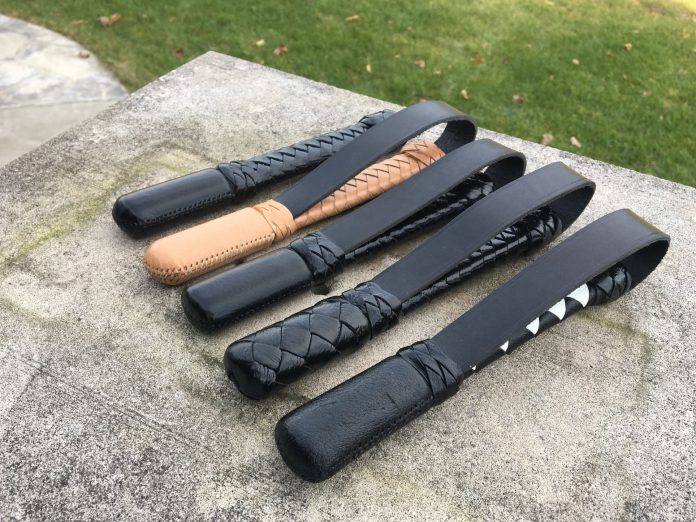
Saps became legal in Texas a few years ago, and given my penchant for travel, both national and international, as well as my regular appearance at many local watering holes, I figured that a better understanding of purpose built tools might also improve my understanding should I be in a position to have to fashion an improvised alternative.
The first time I’d heard of Larry Lindenman was his interview on Ballistic Radio, and I kind of knew that he was loosely affiliated with the Shivworks crowd, but beyond that I didn’t really know much about the guy. And, if I’m being completely honest, his was only 1 of 2 classes that was available on the Sunday morning of Tac-Con in 2019, and I figured I’d rather get some hands on experience with something rather than sit through a lecture on ammunition (nothing against Dr. Topper, it just wasn’t my flavor). So I went into this with literally 0 expectations because I basically had nothing else better to do. Well Dunning Kruger is a motherfucker, as I’ve said on more than one occasion, and the universe decided to choke me on my own ignorance.
I am so glad that I took this class! Aside from the fact that Larry is an incredibly gracious guy (I ended up being able to pick his brain the night prior over a wide range of topics), he takes a refreshingly pragmatic approach to impact weapons. To provide some context, in different Facebook groups you’ll generally see people that talk either about brass knuckles or the “biker’s special” padlock/bandanna combo. The amusing part is that nobody ever seems to address application and targeting, as if it’s as easy as swinging a hammer! As you might imagine, it ain’t exactly that easy.
His application of impact weapons jives well with a grappling foundation, as you’d expect from both a member of the Shivworks crew and a competitive fighter. Access and application were all tight, with elbows almost pinned to the ribs. The blows were thrown not from the wrist, elbow, or shoulder, but from the hips like a boxer’s cross. Larry took great care to specify preferred targeting areas (clavicle, floating ribs, outer thigh), and made it abundantly clear that any blows to the head would likely constitute deadly force. (Check your local laws and, if at all possible, your local law enforcement’s policies regarding batons. I’m in no way a lawyer and none of this constitutes legal advice in any way)
We drilled some scenarios, working (briefly) through MUC (look it up), and into the access and deployment of the sap/jack. What’s different about Larry’s material as opposed to some of the other Shivworks members is that, because of the nature of the sap, access & preparation is actually part of the verbal engagement process. We’re able to get away with this partially because the impact weapons are generally viewed as less lethal force, and the visual presence of a hunk of leather isn’t as overtly hostile as a firearm or blade. Therefore once the aggressor decides to initiate the assault, the sap/jack is already chambered for its first strike and you’re not having to contend with in-fight weapon access. He also showed us a nifty little hack that he’d picked up from Claude Werner about how to make a sap sheath out of an old milk jug.
In between the drills there was also a show & tell where he showed of a wide collection of leather goods that could only be rivaled by Jack Clemons. Larry broke down the anatomy of both saps & blackjacks, the advantages and drawbacks to each, and what he personally looks for in a defensive impact tool. There was also some discussion on makeshift/improvised impact weapons, however that is Larry’s proprietary content, reserved strictly for the course, so you’ll just have to sign up and find out for yourself. That alone is worth the cost of admission in my book.
As stated at the beginning, I’m almost embarrassed at how cavalier I was going into this. Impact weapon knowledge is something that I think everyone could benefit from. If for no other reason than they’re the most universally available. My wife and I love to travel, especially outside the US. Firearms are a non-starter, and blades are dodgy at best. Having an understanding of how & where to hit people, and what to hit them with is invaluable in areas where more conventional weapons may not be an option. There’s only so much that he could cover in the limited 2 hour window we had, but every minute was productive and I cannot speak highly enough about this course.
Shamelessly stealing the Short Barreled Shepherd’s 3×3 Model for AARs, here’s the breakdown:
The top 3 things covered in the class:
- The anatomy of saps/jacks & what to look for
- Positioning/staging/accessing the tools
- Targeting & application
The top 3 things I learned from the class:
- There’s a lot of instances where a sap/jack may be preferred over a knife/gun
- How to make improvised impact weapons
- I have a tendency to over-extend my fence.
Top 3 things I’ll do differently:
- Invest in a decent purpose built sap (for when I travel places that it’s legal to carry)
- Put together a travel kit
- Keep my damn arms in!
If you’re within driving distance of Dallas, TX and are interested in getting more formal instruction with impact weapons, I strongly suggest you sign up for the Small Impact Weapons Instructor course that Steve Moses hosts. He’s also a contributing author on the CCW Safe Blog. Go check him out.



